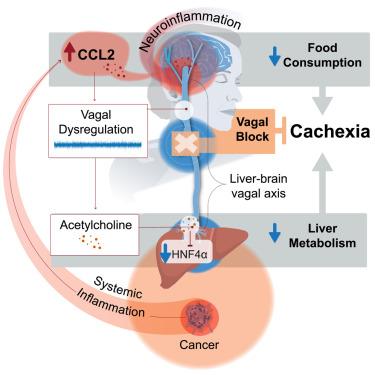迷走神经阻断脑-肝轴阻止癌症相关恶病质
IF 42.5
1区 生物学
Q1 BIOCHEMISTRY & MOLECULAR BIOLOGY
引用次数: 0
摘要
癌症相关恶病质(CAC)是一种多因素且目前无法治愈的综合征,导致近三分之一的癌症相关死亡。它有助于抵抗治疗并增加受影响患者的死亡率。在这项研究中,我们发现癌症诱导的全身性炎症改变了CAC小鼠模型中的迷走神经张力。这种迷走神经失调破坏了脑-肝迷走神经轴,通过耗尽HNF4α(肝功能的关键转录调节因子)导致肝脏蛋白质代谢的重编程。HNF4α的缺失破坏肝脏代谢,促进全身性炎症,导致恶病质表型。通过手术、化学、电或非侵入性经皮装置对右颈迷走神经进行干预,可减弱CAC的进展,减轻其临床表现,并与化疗协同作用,改善小鼠的整体健康状况和生存率。本文章由计算机程序翻译,如有差异,请以英文原文为准。

Vagal blockade of the brain-liver axis deters cancer-associated cachexia
Cancer-associated cachexia (CAC) is a multifactorial and currently incurable syndrome responsible for nearly one-third of cancer-related deaths. It contributes to therapy resistance and increases mortality among affected patients. In this study, we show that cancer-induced systemic inflammation alters vagal tone in CAC mouse models. This vagal dysregulation disrupts the brain-liver vagal axis, leading to a reprogramming of hepatic protein metabolism through the depletion of HNF4α, a key transcriptional regulator of liver function. The loss of HNF4α disrupts hepatic metabolism and promotes systemic inflammation, resulting in cachectic phenotypes. Interventions targeting the right cervical vagus nerve surgically, chemically, electrically, or through a non-invasive transcutaneous device attenuate CAC progression, alleviate its clinical manifestations, and synergize with chemotherapy to improve overall health and survival in mice.
求助全文
通过发布文献求助,成功后即可免费获取论文全文。
去求助
来源期刊

Cell
生物-生化与分子生物学
CiteScore
110.00
自引率
0.80%
发文量
396
审稿时长
2 months
期刊介绍:
Cells is an international, peer-reviewed, open access journal that focuses on cell biology, molecular biology, and biophysics. It is affiliated with several societies, including the Spanish Society for Biochemistry and Molecular Biology (SEBBM), Nordic Autophagy Society (NAS), Spanish Society of Hematology and Hemotherapy (SEHH), and Society for Regenerative Medicine (Russian Federation) (RPO).
The journal publishes research findings of significant importance in various areas of experimental biology, such as cell biology, molecular biology, neuroscience, immunology, virology, microbiology, cancer, human genetics, systems biology, signaling, and disease mechanisms and therapeutics. The primary criterion for considering papers is whether the results contribute to significant conceptual advances or raise thought-provoking questions and hypotheses related to interesting and important biological inquiries.
In addition to primary research articles presented in four formats, Cells also features review and opinion articles in its "leading edge" section, discussing recent research advancements and topics of interest to its wide readership.
 求助内容:
求助内容: 应助结果提醒方式:
应助结果提醒方式:


